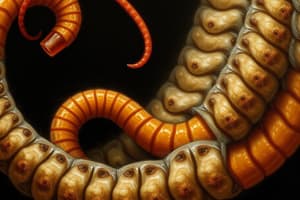Podcast
Questions and Answers
What species are responsible for transmitting Loa loa?
What species are responsible for transmitting Loa loa?
- Anopheles species
- Aedes species
- Chrysops species (correct)
- Culex species
What is a distinguishing feature of the microfilariae of Loa loa compared to Brugia malayi and Brugia timori?
What is a distinguishing feature of the microfilariae of Loa loa compared to Brugia malayi and Brugia timori?
- They have no sheath.
- They possess a curved tail full of nuclei. (correct)
- They have a tapered tail.
- They are smaller in length.
During which time of day are Loa loa microfilariae typically detected in peripheral blood?
During which time of day are Loa loa microfilariae typically detected in peripheral blood?
- Evening
- Early morning
- Night
- Afternoon (correct)
Which of the following symptoms is associated with the migration of adult Loa loa worms?
Which of the following symptoms is associated with the migration of adult Loa loa worms?
What is the typical length of microfilariae from Brugia malayi and Brugia timori?
What is the typical length of microfilariae from Brugia malayi and Brugia timori?
Which clinical feature is characteristic of Calabar swellings?
Which clinical feature is characteristic of Calabar swellings?
What clinical presentation can occur if Loa loa migrates through the eye?
What clinical presentation can occur if Loa loa migrates through the eye?
Which diagnostic method is preferred for detecting microfilariae in a patient suspected of having a filarial infection?
Which diagnostic method is preferred for detecting microfilariae in a patient suspected of having a filarial infection?
Flashcards
Brugia malayi/tiimori
Brugia malayi/tiimori
Cause lymphatic filariasis in Southeast Asia, have similar pathology and life cycle to Wuchereria bancrofti.
Microfilariae size (Brugia)
Microfilariae size (Brugia)
177-230 µm long, with a pointed tail and terminal nuclei, and a sheath.
Loa loa
Loa loa
African eye worm, a filarial nematode found in rainforests of West and Central Africa.
Loa loa microfilariae size
Loa loa microfilariae size
Signup and view all the flashcards
Loa loa microfilariae periodicity
Loa loa microfilariae periodicity
Signup and view all the flashcards
Loa loa adult location
Loa loa adult location
Signup and view all the flashcards
Loa loa clinical presentation (migration)
Loa loa clinical presentation (migration)
Signup and view all the flashcards
Loa loa clinical presentation (swellings)
Loa loa clinical presentation (swellings)
Signup and view all the flashcards
Study Notes
Brugia Malayi & Brugia Timori
- Cause lymphatic filariasis in Southeast Asia
- Pathology and life cycle similar to W. bancrofti
- Vector: Mansonia species
Morphology
- Microfilariae are 177-230 µm long
- Tapered tails with two terminal nuclei
- Have a sheath
Loa Loa
- Also known as the African eye worm
- Filarial nematode found in rainforests of West and Central Africa
- Transmitted by Chrysops species
Loa Loa Morphology
- Microfilariae are 250-300 µm long
- Have a sheath
- Curved tails with numerous nuclei
- Diurnal periodicity (12-2 pm)
Wuchereria
- Adult Wuchereria lives in subcutaneous tissues; sometimes in the subconjunctival tissue
- Life cycle similar to W. bancrofti
Clinical Presentation
- Adult worm migration through subcutaneous tissues is usually painless
- Noticed only when worm passes over bridge of nose or through conjunctiva of eye
- Eye involvement may lead to irritation, congestion and pain (15-20 minutes)
Calabar Swellings
- Migratory, localized subcutaneous edema
- Can appear anywhere on the body, but most common on the extremities
- Develops quickly, may be preceded by localized pain, itching, and hives
Lab Diagnosis
- Detecting microfilariae in peripheral blood samples (daytime)
- Thin blood smear, thick blood smear, or ideally a concentration technique (Knott or nucleopore filter)
Studying That Suits You
Use AI to generate personalized quizzes and flashcards to suit your learning preferences.




